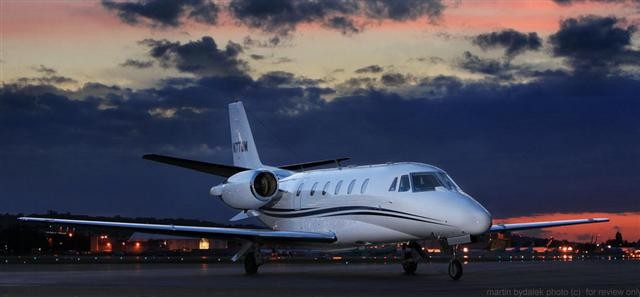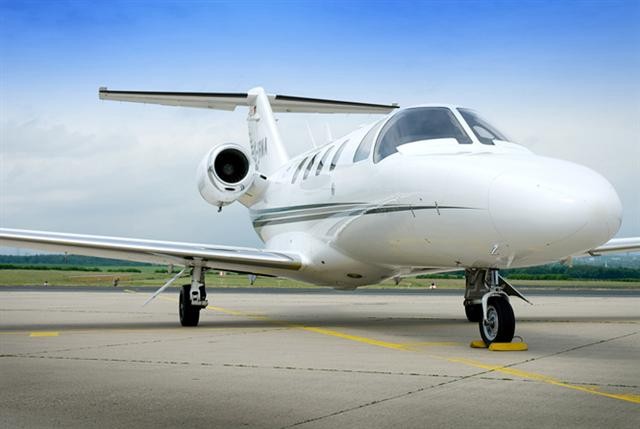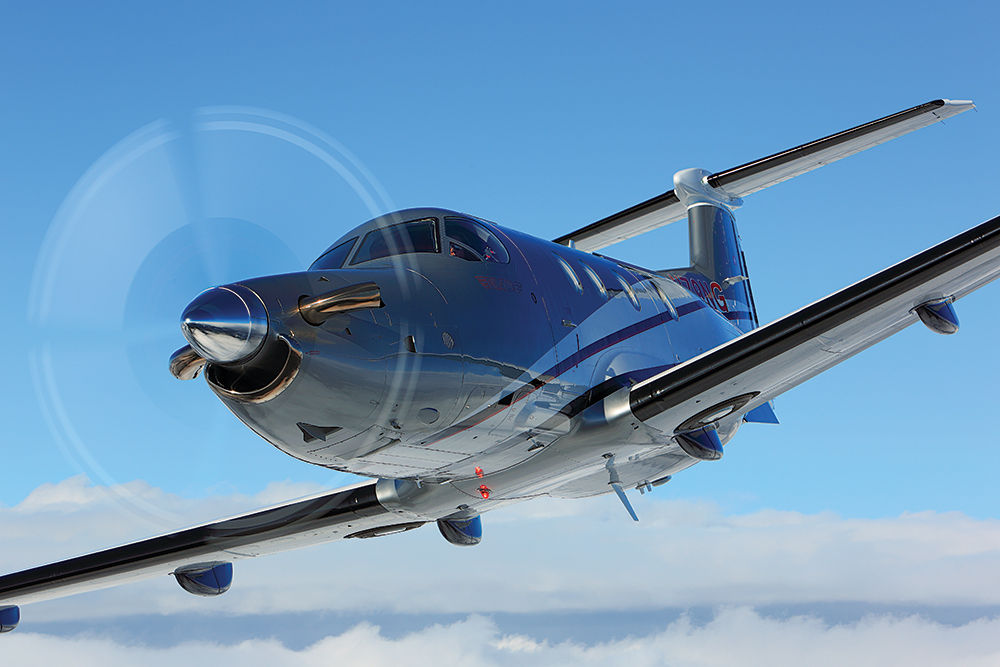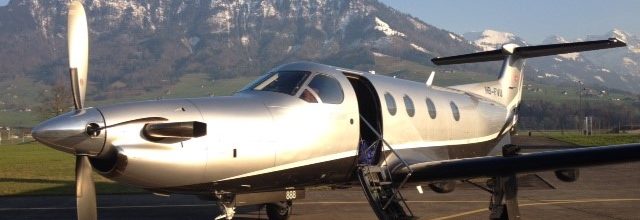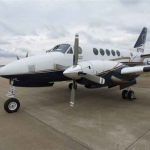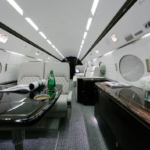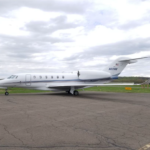The Citation Encore
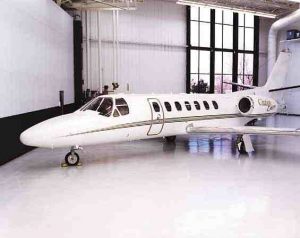
By Tim Palma
The Citation Encore is the “encore” to its successful Citation Ultra. The Encore is versatile, able to fly long distances, take off and land on short runways, and carry a large load. Owners laud its cabin comfort, performance, and its low operating costs.
The cabin, which can hold eight passengers with fully recline seats, stretches to seventeen feet, five inches – the longest cabin of any light jet. The strategic use of seamless wall panels, indirect lights, and mirrors make the cabin seem larger than its actual volume of 3037 cubic feet. Passenger cabin amenities include individual flat panel entertainment systems and audio jacks, power outlets, and the Magna Star 200 radio phone. A newly-designed airstair entryway makes boarding a lot less difficult, especially for passengers in high heels. The Encore has storage space for 43 cubic feet of baggage, or more than 1400 pounds. The Encore can takeoff from a sea level runway in 3,490 feet. The required runway distance increases to 5,760 feet at an altitude of 5,000 feet and a temperature of 77 ˚ F. As far as speed is concerned, in thirteen minutes, it climbs to 37,000 feet, where it can reach its maximum cruise speed of .74 Mach (429 knots). For a long range cruise, it flies at 376 knots at its maximum certified flight level of 45,000 feet.
The Encore’s speed can be attributed largely to its wing design. Keeping with the Citation line’s tradition of simplicity in design and operation, it uses the straight wing design that was such a success on Cessna’s other private jets. Cessna redesigned the standard straight wing that the Citation line had been using. The result was a wing with a large leading-edge radius and a level upper surface, which better distributed air flow, cut drag, and ultimately increased the Encore’s cruise speed. The wings allow the Encore to land on runways as short as 2,400 feet and take off in 3,490 feet when loaded to the its maximum takeoff weight of 16,630 pounds.
It would be entirely unfair to give credit for the Encore’s speed solely to the wing design –the Pratt & Whitney Canada PW535A turbofan engines played a part, too. Each engine provides the Encore with 3,400 pounds of thrust (almost 400 pounds more than the Ultra), while achieving a 16% more efficient specific fuel consumption than the P&W JT15D-5D engines used on the Ultra.
The engines produce enough bleed air to support anti-icing, cabin pressurization, and air conditioning. The Encore’s temperature control system has been updated to use both bleed air and an electrical vapor-cycle machine. The electrical system serves as a backup air conditioning system on really hot days and can be started on the runway to cool the cabin before the engines start. The temperature control system is conveniently designed to allow the cabin and cockpit to set and maintain different temperatures.
The Encore incorporates the Honeywell Primus 1000 avionics suite. Honeywell realized the importance of consolidating multiple displays into four easy-to-interpret displays and placing screens close to the controls that they apply to. One of the predecessors of the Encore had a confusing array of five screens and over eight analog controls. The relevant controls are located directly on the screens’ faceplates to improve pilot hand-eye coordination and flight performance.
The Encore uses a trailing link landing gear for smooth taxiing and soft landings, and can be single-pilot operated. A new forced mixer nozzle cuts engine noise, and new fuel heaters have been added that eliminate the need to mix anti-icing additives with the fuel. Other small updates allow the Encore to carry 344 fewer pounds of fuel and still have a longer range than the Ultra.
Citation Ultra
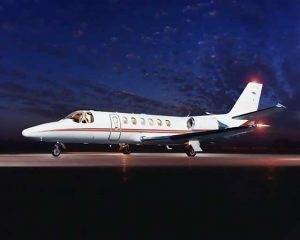
The Ultra cabin is the same as the Encore. Passenger cabin amenities include individual flat panel entertainment systems and audio jacks (an optional feature). The Ultra has storage space for twenty six cubic feet of baggage, or about six hundred pounds worth of golf bags, suitcases, or whatever else worth bringing along.
Arguably the best selling point of the Ultra is its short takeoff distance. The Ultra can pull off a takeoff in just 3200 feet while loaded to its maximum takeoff weight of 16,300 pounds. The Ultra has a cruise altitude of 37,000 feet as well. It has the same wing design as the Encore and is able to achieve similar maximum cruise and endurance speeds
The Ultra has Pratt & Whitney Canada JT15D-5D turbofan engines. Each engine provides the Ultra with 3,045 pounds of thrust. The blades, made from a single-crystal alloy, are part of a wide-chord blade design that has been refined by computer software to improve aerodynamic characteristics. The new alloy also allows the inner tube temperature to go up an additional 68 ° F (when compared to JT15D5-5A engines). The engine design cuts down on air leaks, resulting in better aerodynamic efficiency over the A.
Like the Encore, the Ultra engines produce enough bleed air to support anti-icing, cabin pressurization, and air conditioning as well as providing a temperature control system that allows the cabin and cockpit to set and maintain different temperatures.
The Ultra, like the Encore, can be flown single pilot.
Citation V
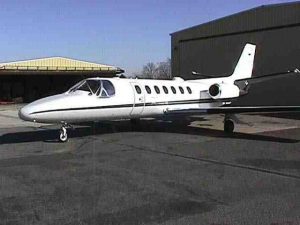
The Citation V is one of the best-selling light jets ever produced by Cessna. It has a good blend of cabin comfort, performance, and reliability.
The deciding factor for most clients comparing the Citation V to other similar jets is often the comfort of the cabin. The Citation V’s cabin is 17.4 feet long, 4.8 feet wide, and 4.8 feet high. Compare these numbers to the Hawker 400XP’s cabin dimensions of 15.6 x 4.8 x 4.9 feet, or the Citation Bravo’s dimensions of 15.8 x 4.7 x 4.8 feet – the difference in length is significant. The engineers of the Citation V took advantage of the extra cabin space and installed extra-wide seats that recline 60 degrees and rotate a full 360 degrees.
The Citation V has an external baggage capacity of 46 cubic feet and an internal capacity of 28 cubic feet. In other words, this private jet can haul about seven suitcases and three golf bags, depending on the specific jet configuration and amount of passengers. Cessna spent considerable time on sound control in its original design of the Citation V. The result was one of the quietest light jets offered in its day. Other notable features include the two-zone temperature control and the ventilation system designed to eliminate drafts.
The cabin pressurization system can hold a sea level cabin to 23,580 feet, which is useful when flying at a high speed (425 knots/hour) cruise at 37,000 feet, or at a long range (350 knots/hour) cruise at the Citation V’s maximum certified flight ceiling of 45,000 feet. Takeoff distances are fairly short. At sea level, the Citation V can take off in 3,160 feet. At an altitude of 5,000 feet and a temperature of 77 ˚ F, the required runway distance increases to 4,780 feet.
It has an average cruise speed of 415 knots per hour and makes it a popular choice for 350 to 400 mile trips. Typical nonstop flights include Fort Lauderdale to New York, Aspen to Los Angeles, and San Francisco to Southern California.
